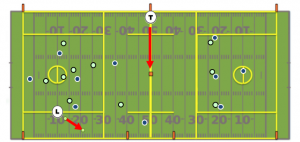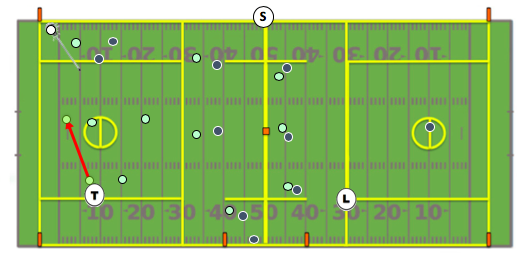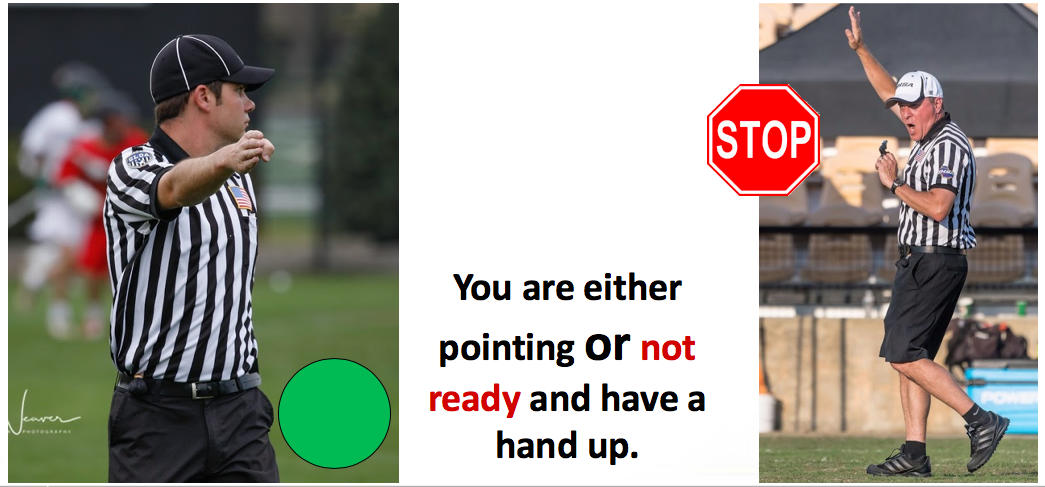Officials are responsible for stopping and starting play. When done properly and consistently throughout a game, officials are able to maintain the game’s ebb and flow. When done improperly and inconsistently, the game can drag on and create confusion. In addition to knowing the basic requirements for a restart, keep in mind when to restart quickly and when to restart slowly. If you switch these up during a game, you will disrupt this flow.
Requirements for a Restart
In order for officials to allow play to start. Officials must make sure that the player in possession is standing on the field, at least one yard in front of the sideline
All restarts require:
-
- Player in possession of the ball
- Ball carrier is in bounds
- No players from the offensive team within five yards of the player with the ball. This includes players out of bounds.
- A defensive player may be within five yards but may not engage the player at all until a five yard buffer has been established.
Here is an example of a solid restart on the sideline. The official does a good job of managing the restart. Ball goes out of bounds, white picks up ball, stops at the spot of the restart, no players from either team are within five yards and the the official blows the play in.
Here is an example of a solid restart following a loose ball push. The ball is loose when blue is pushed from behind. Officials restart play in bounds, with blue in possession and as the football yard lines on the field indicate, white is five yards away from the ball carrier. Blue plants his feet and the official blows the play in.
Quick Restarts
A 2019 questionnaire completed by both coaches and officials indicated a concern regarding pace of play. In the effort to maintain the quicker pace of play, the NFHS rules committee adopted a change this season to Rule 4-5, 4-22 that now allows for an immediate whistle to restart play mirroring current NCAA rules.
Offensive players are still required to be at least five yards of a teammate in order to prevent the hidden-ball trick by the offense. What is new is that a defending player is no longer required to be 5-yards away from the ball carrier when play is restarted, as long as they do not play the ball carrier until the required 5-yard buffer is met. If the defender engages without ever establishing a 5-yard buffer, he will be penalized with a Flag Down Slow Whistle for technical foul delay of game.
These restarts often occur when officials kill a play-on, or after a technical foul on the offense (e.g. ward, or moving pick), when restarting play after a sideline or endline out of bounds. These should be fast but not rushed.
In this example, play is restarted after red is assessed a loose ball technical foul for playing without a crosse.
In this example, the officials restart play after awarding the ball following a shot out of bounds. The official is in great position, uses excellent out of bounds mechanics (hand up, whistle, point direction, hand up and a solid wind) and the restart is quick but not rushed.
Be in Position to Manage the Restart
Officials must manage these restarts. You must be in position to see whether defenders are within 5-yards. Move to a spot where you can see the players and talk to them. Practice preventive officiating by reminding players they cannot engage until they meet the buffer requirements.
Here is an example of a restart following an endline pass out of bounds. And while from a distance both the white and blue players might appear to be closer than five yards to the ball carrier, the official is in great possession on the end line to manage the restart.
Restarts in Crease
When officials award the ball to the goalie on the crease, it is imperative that any riding attackman near on the crease not play the goalie as he is making his outlet pass or exiting the crease. The diameter of the crease is only 3 yards. Simply raising his stick and forcing the goalie to alter his throwing motion is enough to draw the delay of game foul!
Slow Restarts
That being said, there are times a team is entitled to a quick restart and when they are not. Coaches and players are going to yell at you to blow your whistle quickly in nearly every situation; make sure the requirements for restarting play have been met. It is better to be slow and right than fast and wrong.
Slow Restarts occur following:
-
- the start of a new period
- a goal
- a time out
- a loose ball play-on in the attack box
- a time-serving penalty has been reported
- an injury or official’s timeout
- an official’s mistake e.g. pointed the wrong direction when awarding the ball
- a restart occurs near the substitution box
- when goalie is out of the crease prior to a restart (allow five seconds to return)
Slow Restarts Require:
-
- Player must be in possession of the ball.
- Player must be completely in bounds.
- No players from offensive team within five yards of the player with the ball.
- Defensive player MAY be within five yards of ball carrier but may not play him until a 5-yard buffer has been established.
- This includes players out of bounds.
In addition to the standard requirements, make sure that:
-
- The field is set with the correct number of players for the situation (All-even, a team man-up, both teams one-man down, etc.)
- Bench-Side Official keeps the 20-second timer for teams to substitute prior to the Slow Restart.
- Your partner is in position signaling “Ready” by pointing.
- You let the players, and especially the goalkeeper, know where the ball will be restarted from.
Restarts Near the Substitution Box
Any restart near the substitution area requires officials pause and make sure the field is set and that players are safe. The official managing the restart should move the player with the ball 5-yards towards the center of the field; this way any player subbing onto the field is 5-yards away.
In this example, the ball goes out of bounds last touched by white on the faceoff and is awarded to green. The trail official in the two man game, comes up to manage the restart and correctly moves the ball carrier in five yards from the sub box before restarting play.
In three-man mechanics, the Trail or single can easily manage this situation. However, in a two-man game, this restart often occurs in no-man’s land with the Trail on the far side and the Lead down covering his goal. The Trail should pinch in to the near sideline and the Lead and move out towards near sideline to make sure the players are all properly positioned.

The Lead and Trail need to work together to make sure the restart is managed correctly. It is imperative that officials be aware of who is on the other side of the midline and about to sub onto the field.
Deep Restarts Single Side
When the ball is restarted in the defensive end on the far side of the field in a three man game it can be a challenge to make sure that the defenders are not within five yards of the ball carrier.

The new Trail should pinch in to help manage the restart.
Restarts after a Face Off Violation
When you have a faceoff violation, it is key that you manage the restart. It is very likely that you will have lots of bodies very close together. For any pre-whistle violation occurs, officials should restart play one step over the midline and on post-whistle violations occur whenever the ball is when the violation occurred.
However, there is no need to rush the restart, the new Lead and Trail officials should make sure that no players have released from the Defensive Restraining Lines as the faceoff and in a three man game, the Single should always take the restart. This is especially true in a two-man game, as the new Lead must get down to GLE. Pause and allow the players to set up properly rather than rush and catch defenders in a delay.
This is an excellent example of a cre handling a restart following a faceoff violation.
Restarts at End of Close Game
In a close game with time running out, you should expect that the team that is behind will try to take the ball away from their opponents, either by pressing out with their defense or by double teaming the ball carrier. You MUST make sure that defenders establish a five yard buffer before engaging with the ball carrier.
It is imperative that officials be in position to manage these restarts! You can talk to defenders and warn them to keep five yards back, but the onus is on them. In order not to give an advantage to or disadvantage a team, make sure that the ball is restarted EXACTLY where it should be restarted i.e. right where it went out of bounds. This means you may need to wait for a player to get a ball from out of bounds and get to the spot where play should be restarted. Be present and vocal. Make sure your partners are ready before blowing the play in.
In this example, white is down by a goal and attempts to double team the restart at midfield following the hold call. The official is in great position, but the defenders are clearly within five yards and engage the ball carrier. This should be a FDSW for delay of game on white.
Communication is Key
In both two and three-man games there are basic guidelines who should blow the play in.
-
- Trail always has the restart if the ball is leaving the Trail’s half of the field (clearing).
- If ball is in the offensive end and is coming in from the
- sideline the official on that sideline restarts play
- end line or in the Lead’s alley the Lead restarts play
- Trail’s alley then the Trail restarts play.
- If unclear the On Official restarts play
But these are simply guidelines. Game situations may dictate that another official take the restart, e.g. in a tie game with a few seconds left in the contest, the Lead should be at the crease and may give up his restart to the Trail.
When in Doubt, Slow Down
If the restart gets messed up for any reason, revert to a slow restart and make sure both teams have the right players on the field for the next possession, your partner is in position. This is not ideal, but it is better than disadvantaging one team because you rushed.
Knowing who has the restart is the mark of a good crew, but if you are ever unsure look to your partner and communicate who should grab it depending on the situation. Crews should communicate if unsure: “You take it!”, or: “I’ve got it!” are great ways to get the restart moving along.
An important reason to slow down a quick restart for a beat is if your partner is not in position yet. Take a quick look at your partner to see if they are ready. If they are pointing, blow the play in. If not, hold your whistle to give them a second to get into position. This typically happens on a turnover on a busted clear e.g. after an over and back call, you may want to pause for a moment and allow your partner to get to GLE. This means that whenever the ball is dead and you are ready for play to restart, you should be pointing in the direction of play or have your hand up. Your partner might not ever look at you, but if they do, be sure to let them know you are ready!
Always Give Ready Signal
 If you are not ready for the play to start put one hand into the air. One arm straight up into the air is the signal for “Not Ready For Play.”
If you are not ready for the play to start put one hand into the air. One arm straight up into the air is the signal for “Not Ready For Play.”
One arm straight out to one side is the signal for “Ready For Play.” This signal is most often seen prior to a face off, after a timeout, after a time-serving penalty is reported, and during a deep restart. The ready signal should be in line with your shoulder and fully extended. This signal should be easily recognizable from a distance.
